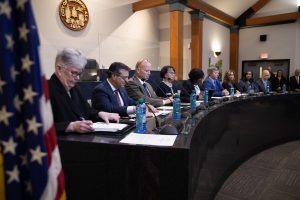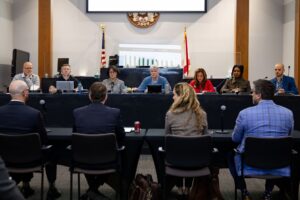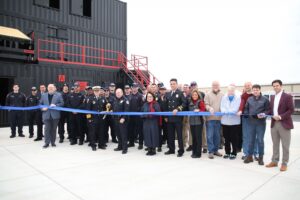NASA is preparing SLS for launch, local celebration events planned
The following is from Claire Aiello and Mike Ward of the Huntsville/Madison County Chamber.
Rocket City, it’s time to rev up our engines and prepare for liftoff of the Space Launch System (SLS), NASA’s next megarocket that will return humans to the moon and then on to Mars.
Since 1972, no human has traveled more than 386 miles from Earth’s surface. Getting people back to the moon will require a rocket capable of lifting more mass into space than we have ever lifted before, and a capsule able to sustain life and protect the crew from the hazards of deep space exploration.
Make no mistake, there is reason to celebrate the many recent commercial launches you’ve seen in the news. These inspire future generations of scientists and astronauts. These launches have taken people and cargo up and into low Earth orbit, then back. Blue Origin makes and tests engine for its New Shepard and New Glenn rockets and for ULA’s Vulcan rocket here in Huntsville, and it’s reported that William Shatner – yes, Captain James T. Kirk – will go up on a suborbital flight in October.
SpaceX’s Crew Dragon has flown operational missions to the International Space Station. Virgin Atlantic has also sent a crew up to the edge of space and back.
None of these rockets have gone beyond low Earth orbit, though. That’s what is different about the SLS – it must go further, with more power, to get to the moon. SLS is the only vehicle capable of delivering the Orion capsule to the moon, and the Orion capsule is the only human-rated vehicle capable of safely carrying astronauts to the moon. A lot of work is being done right here in Huntsville to support these exciting technologies.
How does SLS compare to the Saturn V?
If you are new to Huntsville, the Saturn V is the large rocket you see when you drive by the U.S. Space & Rocket Center on Interstate 565. Many say this is Huntsville’s Statue of Liberty or Golden Gate Bridge, and we say indeed it is. The Saturn V was used during the Apollo program and made it possible to get Americans to the surface of the moon.
The SLS is not quite as tall, but it is actually more powerful. At 322 feet tall, it stands about 40 feet shorter than the Saturn V rocket, but its engines will produce over 1 million pounds more thrust.
The Marshall Space Flight Center (MSFC) in Huntsville managed the SLS rocket components’ design and development and the bulk of the core stage fabrication occurred at the Michoud Assembly Facility in New Orleans. The solid rocket boosters were fabricated at the ATK/Orbital Science/Northrop Grumman Ogden, Utah, plant.
Guidance and control systems for the rocket were also developed and tested at MSFC.
Greek names
Apollo was the name for the Saturn V missions, and the new name you hear is Artemis. If you know your Greek mythology, Apollo and Artemis were twins. Artemis is the goddess of the moon, and this is the name associated with the SLS program.
Artemis I is scheduled to take flight later this year or in early 2022. NASA recently shared pictures of the SLS at the Vehicle Assembly Building at Kennedy Space Center, and the rocket is a sight to behold. Artemis I will send the unmanned Orion capsule to the moon on a four to six-week mission, venturing farther into deep space than any human-rated vehicle has ever gone.
But how much farther?
We’re talking 40,000 miles beyond the moon. The mission will also carry 13 smaller “hitchhiker” 6U-sized CubeSats (about the size of two loaves of bread), which will be released once the capsule is well on its way to the moon.
Artemis II will send the first crew to the moon, but only for a fly-by mission. All the hardware for the Artemis II mission has been fabricated and the rocket is being assembled at the Michoud Assembly Facility.
Artemis III will be the first mission to send a crew to land on the moon in over 50 years, and NASA says this will include a woman and a person of color. Most of the components of the Artemis III rocket have been fabricated, although assembly has not yet begun.
Launch celebrations
We don’t know the launch date for Artemis I yet, but we anticipate NASA will announce it soon, and we will learn it six weeks prior to launch. The pandemic has caused some delays, though. Recently, we learned key members of the launch team died of COVID, according to SLS managers.
As we await a launch date, a local team is planning a series of events to raise awareness of the upcoming Artemis missions and our community’s role in developing the rocket.
The U.S. Space & Rocket Center, the Huntsville/Madison County Chamber, and NASA-MSFC hosted a media briefing Sept. 8 at the Rocket Center to share updates on Artemis and SLS with Huntsville-area news organizations. Speakers included Rocket Center Executive Director Dr. Kimberly Robinson, Huntsville Mayor Tommy Battle, MSFC Director Jody Singer, SLS Program Manager John Honeycutt, and David Beaman, manager for SLS Systems Engineering & Integration.
More local events are planned, starting this month. Add these to your calendar and come join us:
- Oct. 8: “ARTemis” Walk on the Courthouse Square
- Oct. 4-10: World Space Week at the U.S. Space & Rocket Center, celebrating women in space
- Oct. 30: Spooky Space Spectacular at the U.S. Space & Rocket Center
- Nov. 6: Artemis Day on the Square – come to Square dressed as an astronaut
Also, between now and January, breweries on the Downtown Huntsville Craft Beer Trail will serve Artemis-themed craft beers. Participating breweries include Below the Radar Brewhouse, Chandlers Ford Brewing, Fractal Brewing, Green Bus Brewing, InnerSpace Brewing Company, Mad Malts Brewing, Rocket Republic Downtown, Salty Nut Brewery, Straight to Ale, and Yellowhammer Brewing.
The Huntsville/Madison County Convention & Visitors Bureau is updating a special calendar with other Artemis-themed events. Visit huntsville.org/artemis-launch-celebration for additional celebrations.


















